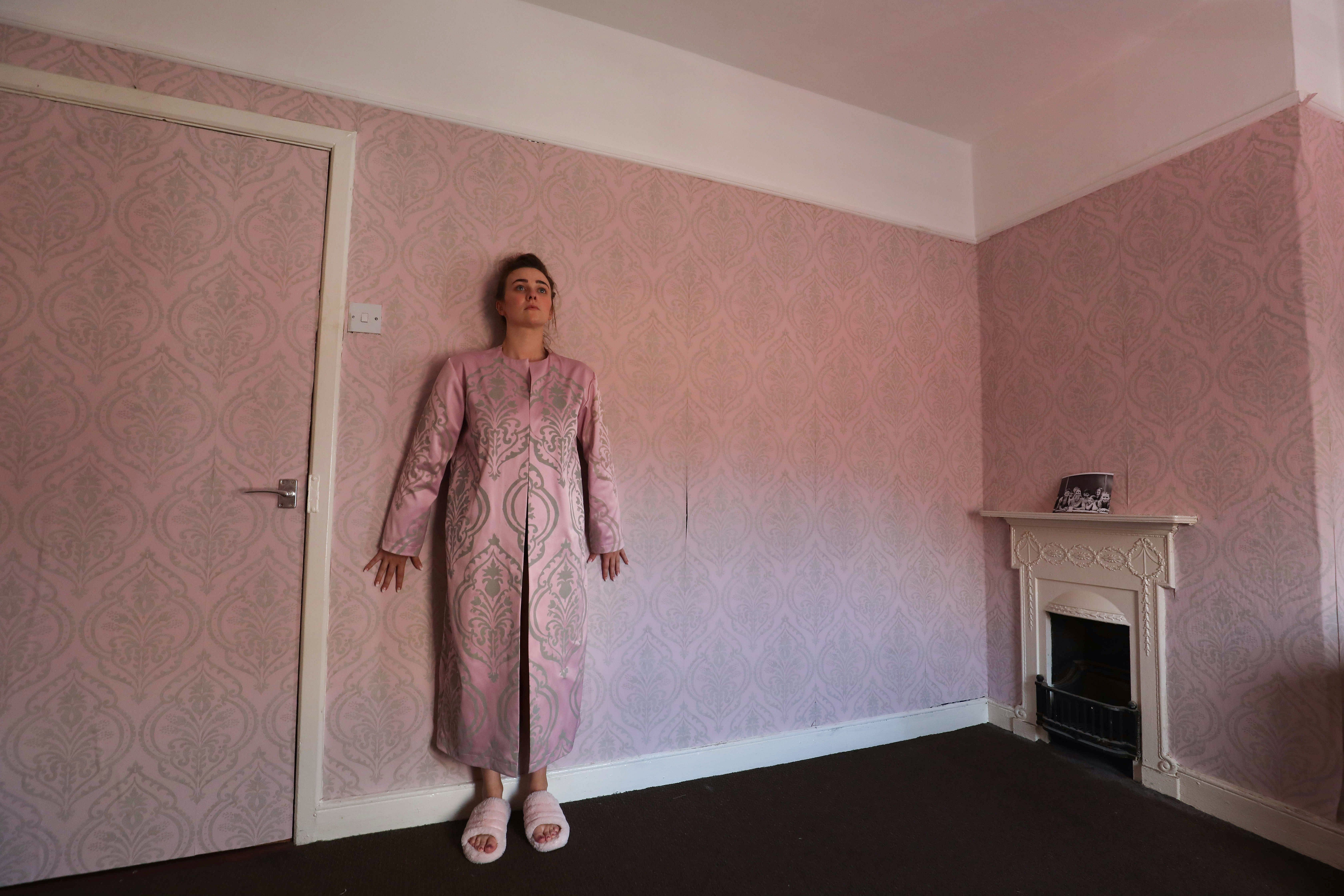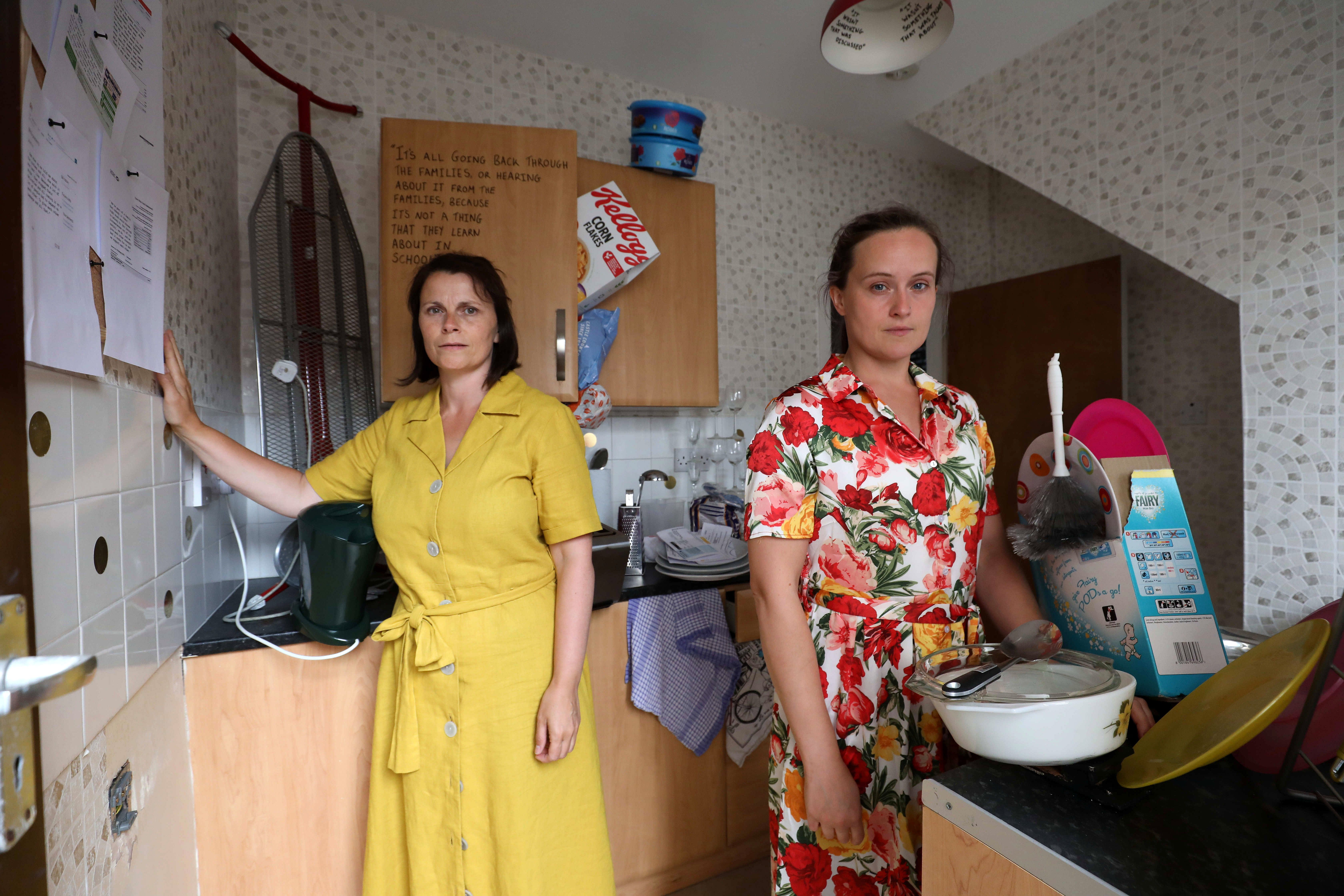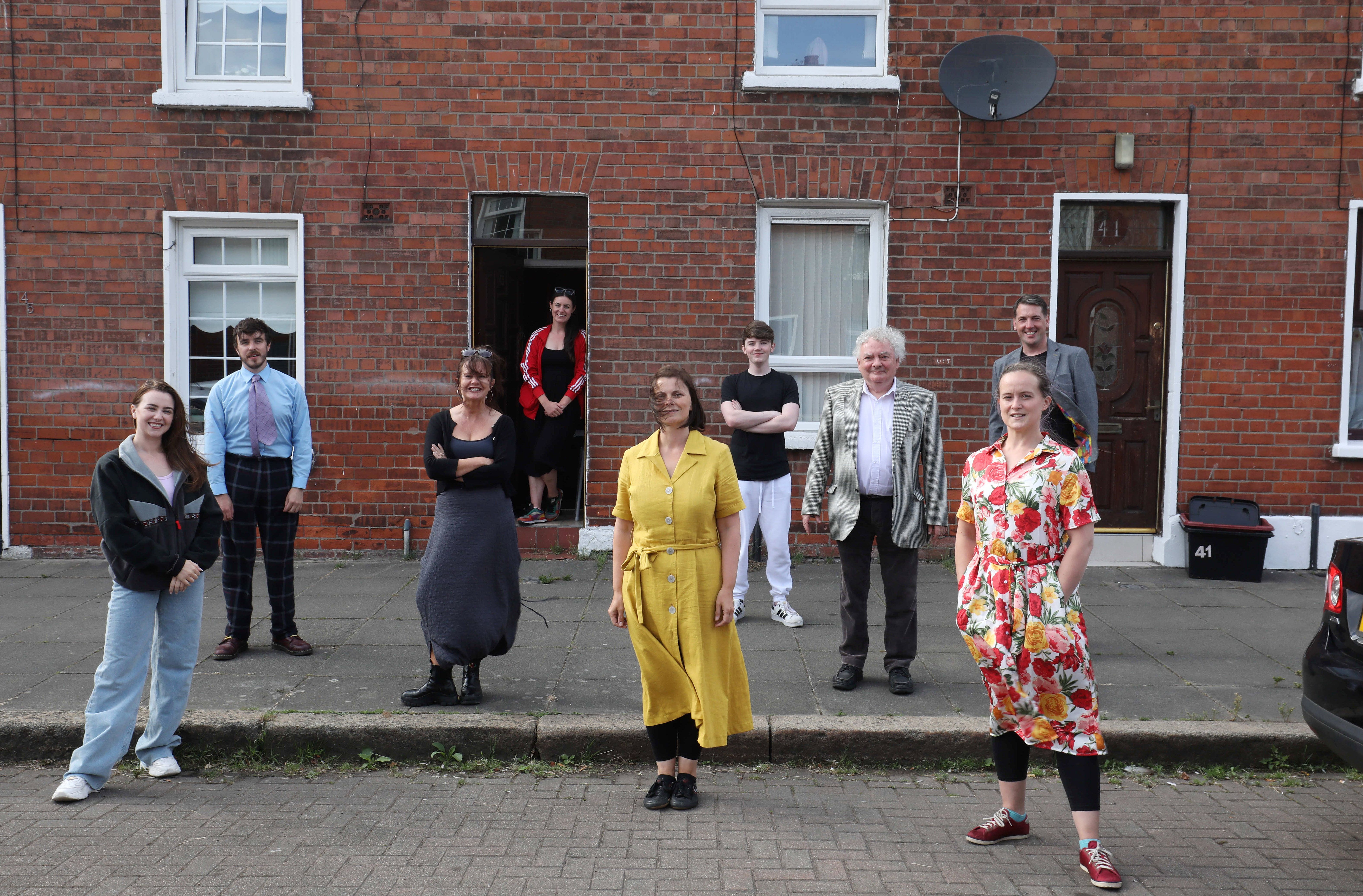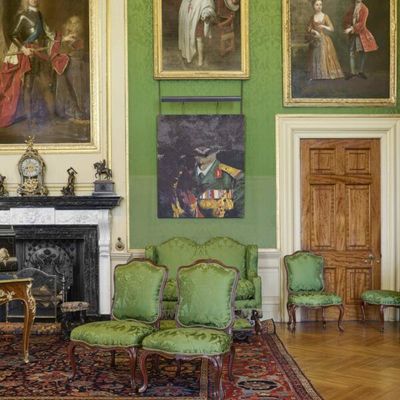The House was billed as part exhibition-part theatre, an intriguing partnership between the Commission for Victims and Survivors, Big Telly Theatre Company and the Northern Ireland Housing Executive in their 5oth year: “the project has been but together to raise awareness of the voices of victims and survivors who would not otherwise be heard.”
Ok that was my hook. I’ve always sought out artistic interventions in this space and am attracted to new ways of dealing with these issues but this is the first time I’ve noticed one of the Commissions using the art in this way.
Registering online as part of the event I was interested to see it was available both in Hamill street in West Belfast and Tullycarnet in the East. Giving an opportunity for that East-West interchange.
Booking online there was availability for four people to enter a house at the same time with masks. When I arrived, It was explained to us that the theatrical experience consisted of a man who would appear as an estate agent who would be taking us through the house as if we were going to rent it, in each room there would be previous tenant going about their business that only we could see.
We were the first group to arrive, I’d not been in Hamill street before and enjoyed its wide proportions and red brick. I was surprised that some of the houses were still owned by the Housing Executive. We were welcomed into the first room by Chris Robinson who was our guide. He invited to sit on a sofa.
The House, an interactive installation dealing with the conflict, at 43 Hamill Street.
— Féile an Phobail (@FeileBelfast) August 6, 2021
An initiative by the Victims and Survivors Trust. pic.twitter.com/SHTWCfZcym
Performer Niall Cusack was in a chair beside the window and started to talk about "the sacrifices that people had made during the Troubles”, what they were fighting for and the importance of always remembering”. A younger man came in (played by Jonny Cameron) who started to tell him to "stop going on about it, it happened a long time ago and it was better to move on”.
WALLPAPERED: Debra Hill
The conversation continued on like this and as I was watching I realised only two weeks before I was taking to a friend who talked about having this very experience. Then quickly the roles reversed, the younger man started to say the words of the older man and vice versa. They changed seats. The older man was saying to forget it and move on, the younger man talking about not forgetting those who sacrificed all. It was as if we were witnessing intergenerational trauma mirrored back to us in real time.
HIDE THINGS AWAY
Egg shells were placed on either side of the narrow stairs up to the first floor. In the bathroom we were invited to look in the cupboards. They were filled with tablets while prescription pads around the cupboard were filled with quotes about medication and how people medicate to get by. The airing cupboard, “where we are invited to hide things away,” is filled with horror and gore.
IF THESE WALLS COULD SPEAK: Helen Ashton and Diane Quate
Continuing up the stairs in the half-light, quotes and dialogue directly drawn from research on behalf of the Commission by academics including the Ulster University and Queens were painted: all were familiar.
We reach the front bedroom and are invited to sit, here we watch a young women played by Debra Hill get ready to go out on a Friday night as she puts on her makeup and talks about her mother of how she is scared to be in the house alone. It slowly becomes clear that this is a ritual she does every Friday night, only to never go out at all. Her life is stalled by her mother’s trauma. She becomes invisible, dressing herself in a gown the same pattern as the wallpaper, as if becoming wallpaper herself.
Off into the box room. “Good for a home office,” says our guide. We find a young schoolteacher, played by Gavin Peden, trying to deliver a class over Zoom. He is in his pyjama bottoms but with shirt and tie. The pupils are asking him questions about the troubles and he replies that he can only deliver what is on in the curriculum. His mum calls to say not to tell the interviewer in Oxford for the job he’s going for where he comes from.
Next we see her up on the Zoom call, projected onto the wall. We all know her: she is from Northern Ireland and left years ago to live and work in England. In fact it might be me if I had not come home. She is aware but dislocated from the contemporary everyday realities of living and teaching locally.
On the wall are notes about papering over the cracks, something that we are well used to doing. Down in the kitchen, Helen Ashton and Diane Quate are doing their best to keep it together — as women do while the men continue their talk in an intergenerational trauma loop in the living room. In through the window comes the help of a drink. Throughout the house your eye catches more quotes taken from the University research. “Why mummy’s angry” caught my eye. Quotes are even written on the linen in the back yard.
TEA AND CHOCOLATE
The piece in all took around thirty minutes. There was a welcome tea and chocolate at the end where you were invited to give feedback. One man in his 60’s spoke of being trained as a teacher and never knowing how Ireland was partitoned as is was not on the curriculum and talked about only in side conversations with pupils.
REVERSED ROLES: Jonny Cameron and Niall Cusack 
We were asked did we know about the Victims and Survivors' services. Did everyone who was traumatised know where to ask for help? One man said he thought they did but that many people were not affected and did not need them. My answer was slightly different as, with the work I have done, I have come to know that we have a large societal trauma body across our society. However, it’s so endemic we hardly notice. It was only ten years ago at a conference I realised that I myself had been experiencing trauma and I consider myself never to have been be in the thick of anything growing up. It was always happening somewhere else — or so I thought. The piece about the children at school brought a tear my eye and the job of working from the same curriculum a monumental one. We all have different narratives to tell.
Like any really excellent exhibition you always want to go back more than once and as I’d been in the first group to visit the experience I was curious how someone not brought up here but who has lived here for the last twenty years would experience it so I booked in with a firend for one of the last performances in a 1970’s flat in Tullycarnet.
Northern Visions had sourced footage of Hamill street and Tullycarnet for the experience to be played in the living rooms when you first entered. As I watched the footage of when Tullycarnet housing estate was first built, I watched Peter and Iris Robinson among other local politicians at the opening. I considered how much their lives had changed but maybe not much had changed for the current residents. This time it seemed I had more time to view the quotes on the walls; the actors were well into their roles forty performances on with no signs of flagging.
A few tweaks here and there where the actors looked you straight in the eye and asked you: “what you thought?”. No tears for me this time and my companion’s reaction was one of feeling deeply sad for the young woman not able to move on with her life. Thinking about both houses the classic Belfast red brick terrace and the 1970’s Council flat, the thing that struck me was that there was no more space in the flat than in the terraced house. Were we not trying to improve the housing?
KUDOS TO BIG TELLY
Well done to Big telly Theatre Company, the Commissioner for Victims and Survivors and the NI Housing Executive for this partnership I think we need more of this kind of work and it should be toured. When looking at the list of Victims services online, I wondered where were the art and drama therapists? I wondered where is the support for the artistic events that work on the larger societal trauma body? Everyone who came had different triggers and observations about the piece some of which were captured. There is much more of this work needed. Not just in using drama but other art forms as well.
The Victims and Survivors of the Troubles/Conflict would like to hear from people who are ready to share their experiences with them so that they can feed this into their policy development responses or signpost them to services.
Sometimes this work seems endless and we are only at the beginning but everything has to start somewhere.
More reasons to visit East Belfast - thanks to @NationalGallery you can find art by Jan van Huysum exhibited alongside @Wee_Nuls pic.twitter.com/GTnbHodSEE
— Ken Bartley (@Ann_and_Ken) August 13, 2021
I thought hell had frozen over when I saw The National gallery, London had taken over a space in Portview Trade centre on the Newtownards Road along with NI Museums to bring one of it’s masterpieces to East Belfast. The National Gallery is in Trafalgar Square, Londo,n and I remember many trips there as an art student led by an eccentric History of Art tutor who loved to share her knowledge of ancient paintings of Saints.
HYPER-REALIST
This exhibit in Belfast was of an 18th century painting by Van Huysum know in his time for his hyper-realistic paintings of flowers. This is a great initiative to democratise an art collection but I felt for the two security guards and staff who had to cope with a kind of aural torture with the sound installation than accompanied it. They should have given art lovers some peace to view it.
‘As I Cannot Write’ is a solo exhibition of new, on-going work by visual artist Cathy Scullion.
— Vault Artist Studios (@VaultArtistsNI) August 6, 2021
Viewing by appointment 10am-4pm daily until Friday 13th August.
To arrange a viewing contact Cathy through insta @cscullionart or by email: cathy@vaultartiststudios.com pic.twitter.com/x3nXVpDsR8
The Vault artists’ studios, also in East Belfast, now have monthly exhibitions and Cathy Scullion's ‘Exhibition as I Cannot Write’ was a kind of haunting tribute to the things women have not felt they could speak about. First she asked people for letters describing times they could not speak about something. Then she crocheted each story and made an installation out of the pieces. We had a nice chat about how thankful she was about the Arts Council emergency support programme last year and the wonders of Zoom for participating in art well beyond any borders. It will be interesting to see how her work develops. The Arts Council have a great funding call out at the moment called the digital evolution awards. They are available for upskilling artists in the use of digital technology with awards of up to £10,000. Details on their website.
On a cheery note, Miguel’s Martin and Isobel Anderson’s Lets do an Art series commissioned by the MAC are now all online for the child inside everyone, episode four features a mean seagull.
The Cathedral Quarter Arts Festival who made a good call postponing their festival until September 2 some shows are already sold out but plenty to get you out again if you’re reticent.
It's taken 18 months to get here - there'll be masks, social distancing etc. but we've finally got ourselves and arts festival. Please see https://t.co/PoF8L46Vol for all shows. @bronaghgall @LisaHannigan @camilleos @andrewismaxwell @KilaRecords @ciaran_lavery @thebonnevilles pic.twitter.com/PMn2tLPduj
— Cathedral1/4ArtsFest (@Cqaf) August 6, 2021
It was nice to see many people out for Late Night art when all the Galleries are open late, the next one is Thursday 2 September. Maybe I will see you there?







